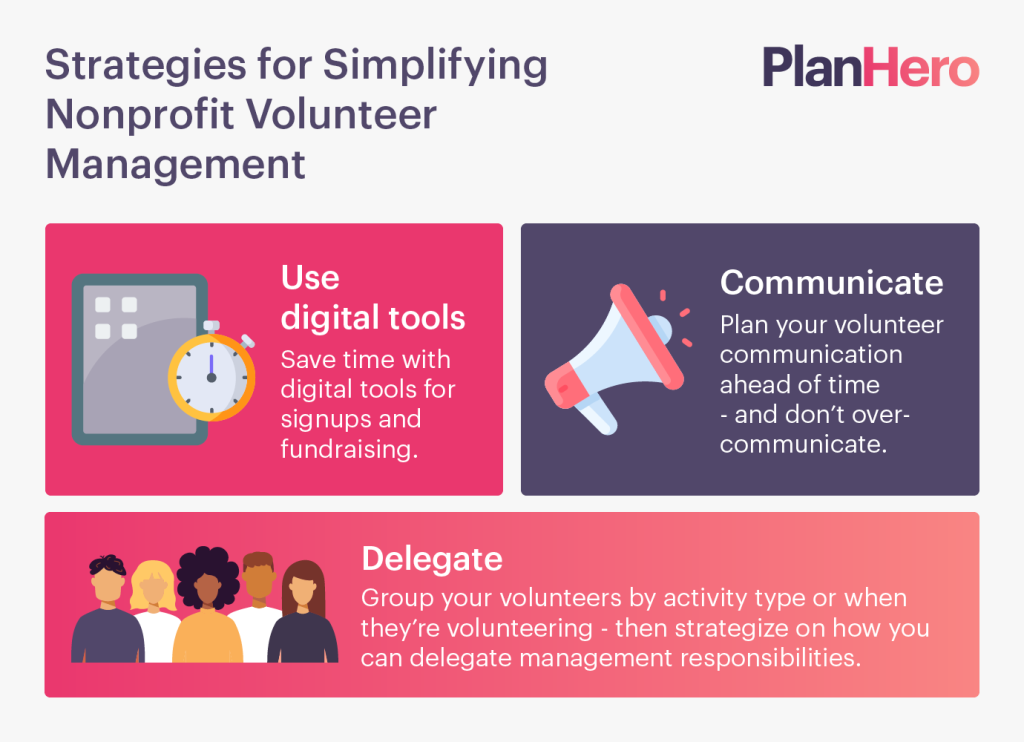Effective Nonprofit Volunteer Management Is Critical to an Organization’s Success
Most nonprofit organizations face myriad challenges to sustain their services and very existence. From continual fundraising to efficacious operations, and from board administration to volunteer management, the struggle is real and unrelenting. As noted in Statistica’s chart below, limited staff capacity and difficulty recruiting and retaining quality staff are nearly as concerning as rising operating expenses.
Recruiting and retaining high quality nonprofit volunteers can reduce the negative impact of limited staff capacity. Reliable, dedicated volunteers can bridge the knowledge gap between departing staff and new staff. In fact, a solid, well-managed nonprofit volunteer corps can aid in reducing staff turnover and in new staff recruitment. And finally, there is a strong correlation between volunteering and donating to the organizations for which one volunteers. For Fidelity Charitable®, 87% of volunteers say there is an overlap between their volunteer and financial support. So the more volunteers you have, the more donors you are likely to have.
In this guide, we’ll cover:
- Recruiting volunteers for your nonprofit
- Managing your nonprofit’s volunteer program
- Strategies for simplifying nonprofit volunteer management
A lesson we see over and over is that those who give are motivated to give more once they see and experience the real effects of their charity.
– CSS Fundraising in their article for The Chronicle of Philanthropy

Recruiting volunteers for your nonprofit
Recruiting and retaining good volunteers requires a sustained effort on the part of every nonprofit. To lasso dedicated volunteers, you’ll need to deliver messaging that resonates with your prospective volunteers. We also recommend that you capitalize on your current volunteers by asking them to encourage their friends to join them in volunteering. By being specific about your needs with all of these potential newcomers, the likelihood of striking the right fit increases.
Other potential sources include:
- churches
- schools
- service clubs
- social media
- those found using Google Ads
Make it resonate
Before you actively start recruiting new volunteers, give some thought as to the type of individuals you are seeking. Try to group them into a few categories, then spend some time thinking about the type of messaging that will resonate with that group. It may take a little research, but it’s worth your time.
As The Chronicle of Philanthropy quoted the work of the University of Maryland’s Robert Grimm Jr. and Nathan Dietz – “underlying reduced rates of volunteering and civic engagement were three social trends: declining religious affiliation, delayed family formation, and the aging of baby boomers. A population that is less religious, has fewer children, and includes more people who have left the workforce will also have a harder time maintaining volunteer participation in organizations and associations.” Fewer people are formally volunteering on a recurring basis, so to recruit new volunteers, your messaging must resonate deeply with them.
For instance, if you know that diversity, equity, and inclusion (DEI) themes and leveling the playing field for upcoming generations resonates with Millennials (which it does according to the CSS 2023 Philanthropy Landscape report), then think about how you can create messaging around those topics for your nonprofit.
As an example, a children’s science museum can showcase a diverse board of directors and its programs to encourage Latinx and African-American children to enter STEM fields where they are historically underrepresented. So even though a prospective volunteer may not be interested in science, they may be very interested in finding ways to help an underrepresented population pave a way to a high-paying vocation.
Get friends to bring friends
Just as the most effective marketing technique is a personal referral or “word-of-mouth,” nonprofits can benefit greatly from leveraging the friends of their current volunteers. Make sure that your current volunteers know that you are seeking additional volunteers. Arm them with knowledge of the many ways volunteers can help your nonprofit. In addition, make sure that your volunteers are crystal clear on your organization’s mission and how it is being executed.
You can make it easy for friends to tap their network by offering exclusive tours of your facilities. Or consider a series of cocktail parties for volunteers and their friends. Board members will often offer to host such gatherings and possibly underwrite them as well. Include a short presentation about what your organization does and how it impacts the community.
Tap into local groups
Don’t forget to tap into organizations in your community. Many high schools, for example, require a prescribed number of volunteer hours in order to graduate. Local faith organizations often want to have sustained volunteer relationships with nonprofits in their neighborhood. Reach out to service groups in your area such as Lion’s Clubs, Kiwanis Clubs, and Rotary Clubs for special projects.
Be specific about your needs
According to Pew Research, nearly 75% of Americans experience stress sometimes (36%) or frequently (36%). The good news is that the Mayo Clinic has outlined various mental and physical health benefits of volunteering, including reducing stress. By being specific about what your volunteer needs are, a person contemplating volunteering will have a pretty good idea of what is expected of them on your organization’s behalf. So don’t add to their stress by having someone show up to volunteer when you don’t have a job for them to do. Just let them enjoy the stress reduction benefit of volunteering!
Use your local media and targeted Google and social media ads
Despite the cacophony of negative news aimed at us daily, local media outlets love a feel-good and/or underdog stories. Share your successes (and your needs!) via press releases to local television, radio, and newspapers. All of these outlets have digital channels as well to amplify your message via all mediums.
Use social media to showcase your good work. Post content that shows your volunteers in action. Post data that demonstrates the impact you are having. While data (facts and figures) are compelling to some volunteer prospects, case studies or storytelling will be more compelling to other prospective volunteers. And in some cases, it’s the merging of these two types of communication that will be the most impactful.
For example, for one person, seeing a chart showing how many new winter coats were distributed by XYZ.org to the unsheltered over the past 10 years would be meaningful to one volunteer, while another might relate more to a personal story of a volunteer handing a winter coat to an unhoused mother on the streets.
If you haven’t already, take advantage of Google Ad Grants. Approved organizations can receive up to $10,000 per month to spend on Google Ads. Not only can you use this money to advertise your need for volunteers, you can use it to connect with new donors, advocates, and beneficiaries as well. If this is all new to you, consider leaning on experts like Getting Attention to guide you through the process.
Managing your nonprofit’s volunteer program
The most important factor to always keep top-of-mind for your nonprofit volunteer management is to remember that volunteers are just that: volunteers. They are choosing to donate their precious time to help your nonprofit. It is your job to ensure that they want to continue to make that choice. So how do you do that?
You make sure that you:
- are organized and don’t waste their time
- engage them and convey the impact of their work
- thank them
Get Organized and Don’t Waste Their Time
There are, of course, limitless ways that people volunteer for nonprofits – some require in-depth training, and others do not. Make sure that you have some form of an on-boarding program for your volunteers. This may be asking them to watch a short video overview of services that your nonprofit provides, or it may be a series of in-person training sessions. You may also want to include vocabulary that is specific to the population you serve. For example, using phrases and/or terms such as people experiencing homelessness, unhoused, and unsheltered, are preferred to homeless people. The word children or students is often more desirable than kids. In your on-boarding, also make sure that you have volunteers sign any waivers/releases that are required, along with processing background checks if needed.
Remember that every volunteer is an ambassador to the rest of the world for your organization. Arm them with the information they need!
If your nonprofit has regular volunteer meetings, make sure that they are scheduled and readily available on an easily accessible calendar. In meting out the actual volunteer work, understand what all of your volunteer needs are in advance. By breaking down the work into clearly defined roles, both you and the volunteer will know precisely what’s expected.
Think shorter shifts
Speaking of breaking down the work, if you have long chunks of time to cover, break them into smaller time periods. Two hours seems to be an ideal amount of time. You can always allow people to take more than one two-hour time spot, but by keeping them short, you are able to cast a bigger volunteer net. For example, the busy mother of three may need to attend three soccer games on a Saturday, but she may be able to cram in a two-hour time spot reading to at-risk children at your center. There’s no chance she can make a four-hour commitment. And remember, since volunteers tend to donate to the nonprofits for which they volunteer, the more volunteers, the better! Here’s an example signup for a fundraising event.
Add floaters
As stated above, we are big fans of breaking work down into clearly defined roles. But what if everything doesn’t go quite as planned? You may want to assign a person or two the role of “floater” or “miscellaneous” or “jack/jill-of-all-trades.” Make it clear in the role description that they will be deployed as needed. This way, if someone doesn’t show up or arrives late, or if a particular facet runs long (such as check-out at a gala), you’ll be covered. In the case that everything does run smoothly, have a few tasks to which you can still assign your floater. This way, no matter what, they will feel that their time is being used efficiently.
Engage Them and Convey the Impact of Their Volunteer Work
Engage
When you are on-boarding new volunteers, have them fill out a questionnaire form. They may have shown up because you needed help with your landscaping, but it may turn out that they are a graphic design whiz. In the questionnaire, include all the different categories of needs that you have and encourage them to check away. Here’s an example.
For smaller organizations with very limited staff, think broadly here. As the executive director, you may be deeply steeped in the strategies for addressing the needs of the unsheltered or an expert in horticulture, but you may be a newbie to Quickbooks. Further, what if you had a great volunteer who loves photography and could come in once a week to shoot photos of your operations…your gardens…your pets? Combine the photo-bug with someone who can do social media in their sleep. Engage them with volunteer work that resonates with them. Ask them what they love to do most and find a fit for them.

Impact
Make sure your volunteers understand the value and impact of their efforts. Even if it seems to have no connection to the nonprofit’s mission (e.g. our Quickbooks helper above), the volunteers need to understand that because of what they do, the organization is able to deliver X to the community. Then drill that down one step further. Because we deliver X to the community, Y is going to happen.
What does that look like in real life? Let’s say that because of your volunteer tutors, your organization was able to provide 1,000 hours of after-school tutoring to at-risk teenagers, reaching 100 students. Okay…that’s wonderful, but what does it really mean? Follow the thread through to deliver more meaning; more impact. The Bureau of Labor Statistics states that high school graduates (in 2022) make 25% more than high school dropouts. Wow. Further, the group with the highest unemployment rate were, guess who? High school dropouts. So the real story here is that by volunteering, you are collectively helping 100 people have higher paying jobs and be less likely to be unemployed in the future. Awesome!
Thank Your Volunteers – Voluncare™
It seems obvious, but always remember that thanking your volunteers is a very good use of your time. We take a deep-dive into why you need to show your gratitude, as well as some more creative ways to do so in our post about volunteer appreciation here. My favorite is Create unique categories of outstanding volunteers…you can have a lot of fun with it. In short, skip the annual volunteer thank-you luncheon (it’s just one more thing to add to a busy volunteer’s calendar), and think outside the box.
When I volunteered to help with science segments for my children’s school, I loved getting the handmade card signed by all of the kids…sometimes with a note or two about something special that we did together. This was far and away more meaningful to me than a one-size-fits-all volunteer appreciation luncheon.
In addition, thank people often. Don’t make it a “once a year” show of appreciation. Again, social media is a great (and inexpensive) way to single out one or a couple of volunteers at time. Think about the special gift(s) that they bring to the organization and highlight it in your post.
Voluncare™
Another way to “thank” your volunteers is to be perennially considerate of them and their time. Show them that you care. This may be in the form of a volunteer lounge at your big annual event. Stock it with refreshments and snacks to keep your volunteers rested and refreshed. It might be ensuring that you have water bottles on a hot day or hot coffee on a cold one. It might mean logo jackets or heat lamps at a cold check-in or check-out desk, or perhaps interior windshield cleaner for your meals-on-wheels drivers. Consider recruiting a volunteer to be in charge of Voluncare™.

Strategies for simplifying nonprofit volunteer management
There are so many different ways to volunteer. For example, managing volunteers for an annual fundraising gala is quite distinct from managing a weekly group of volunteers delivering medical care on the streets. As a result, there are no one-size-fits-all solutions for simplifying nonprofit volunteer management. That said, there are areas of overlap in which digital tools, such as for organizing groups and fundraising efforts can be extremely useful for simplifying nonprofit volunteer management. In considering simplification, how and how often you communicate should also be evaluated. And finally, remember that delegation is your friend. Get in the habit of breaking big projects or initiatives into smaller chunks, the assign volunteers to lead those more manageable efforts.
Use digital tools
One must strike a balance with the use of digital tools for nonprofit volunteer management. The United States Census Bureau reported that in 2021, Gen X (then ages 41 – 56) was the generation with the highest rate of formal volunteering. Most people in this generation are pretty comfortable with tech, in fact they expect it. Yet, Baby Boomers, who are typically digital immigrants, still play an important role in volunteering. Covid-19 went a long way to force Boomers into the digital world, but many still do not relish it. The key here is to implement tools that are as simple for all stakeholders as possible, but still get the job done.
Use digital tools in places that save both you and your volunteers time. If you’re still using a spreadsheet to organize your volunteers, there are better solutions. If you are still running fundraisers with spreadsheets and pieces of paper, there are better solutions. Yes, it takes time to make a change; to stop doing it the old (inefficient) comfortable way. But you owe it to yourself, your organization, and your volunteers to streamline your operations where possible.
Digital signups
For example, in developing our PlanHero platform, we wanted to make it easy for a person to quickly create volunteer signups. Equally, we wanted to make it easy for volunteers to then sign up. We send out reminders so that the organizer doesn’t need to, and a volunteer can edit their own signups, so they don’t have to contact (bother) the organizer. We created a Group Page so that all of the options for volunteering at an organization can reside on one page with one link … eliminating constant updating of links as each new opportunity arises.
Digital fundraising
For fundraising, there are numerous digital platforms that keep all of your auction/event information and donations in order, and will typically increase the amount of funds raised. A few examples include Auctria, SchoolAuction.net, and Handbid. Incorporating fundraising software into your organization will be welcome gift for your volunteer auction/gala/event chairpersons. In addition, the transfer of information from the volunteer team to the nonprofit is automatic. You will eliminate the need to hand-over the “binders” from year to the next!
Communicate…but don’t overdo it
Think before you blast. Communication is important to get information out to your volunteers, to share their impact, and to thank them. That said, it’s imperative that you do not over-communicate. While Covid-19 helped to bring many people into the digital world, it also made many numb to it. Harvard Business Review references a Gartner study that reported that 38% of employees feel that they receive an “excessive” volume of communication at their organization.
The more organized you are, the less you’ll need to send out spurious communiques. Simply your volunteer communications by thinking ahead. Can what I want to communicate right now be handled in our newsletter instead? Can I create a repository for FAQs so that I’m not constantly peppering people with emails?
Tip: Consider enlisting a volunteer to research digital options for your needs. Then consider enlisting that same volunteer or another one to implement it and train you and the rest of the staff on it. Also note that the purveyor of the software will likely be very happy to help you get up to speed. Your success is their success.
Tip: To ensure that your emails are getting through email provider spam filters, ask your volunteers to add your various email addresses to their contacts (for example noreply@planhero.com and info@xyy.org).
Delegate
For small to mid sized nonprofits, it can be difficult to delegate. Rather than viewing your nonprofit volunteer management challenge as herding 100 cats, strategize as to how you can delegate management responsibility. Are there 5 – 10 natural groupings of your 100+ volunteers? Think in terms of what they’re doing or when they’re doing it. Do you have some seasoned volunteers whom you trust and who can act as group leaders? By creating these groups, you are also going to eliminate some of that spurious communication that doesn’t really apply to everyone. Many of the digital tool suggestions that we’ve made above will allow for management and communication by group rather than a one-group-for-all approach.



